Business Environment Analysis Report: Tesco and Macro Factors
VerifiedAdded on 2023/01/07
|20
|5511
|48
Report
AI Summary
This report provides a comprehensive analysis of Tesco's business environment, examining its internal and external factors. It begins by defining the business environment and its significance, followed by an exploration of different types of organizations, including public, private, and voluntary sectors, along with their purposes and legal structures. The report then delves into organizational sizes and scopes, categorizing businesses as micro, small, medium, and large. It analyzes the functions and structures of Tesco (a public organization), Iceland Foods (a private organization), and Public Health England (a voluntary organization), highlighting the relationships between different organizational functions. The report also examines the impact of the macro environment on businesses, including a SWOT analysis of Tesco, and concludes with an overview of the company's strengths, weaknesses, and external factors. This analysis aims to provide insights into Tesco's operations and its position within the UK retail market.
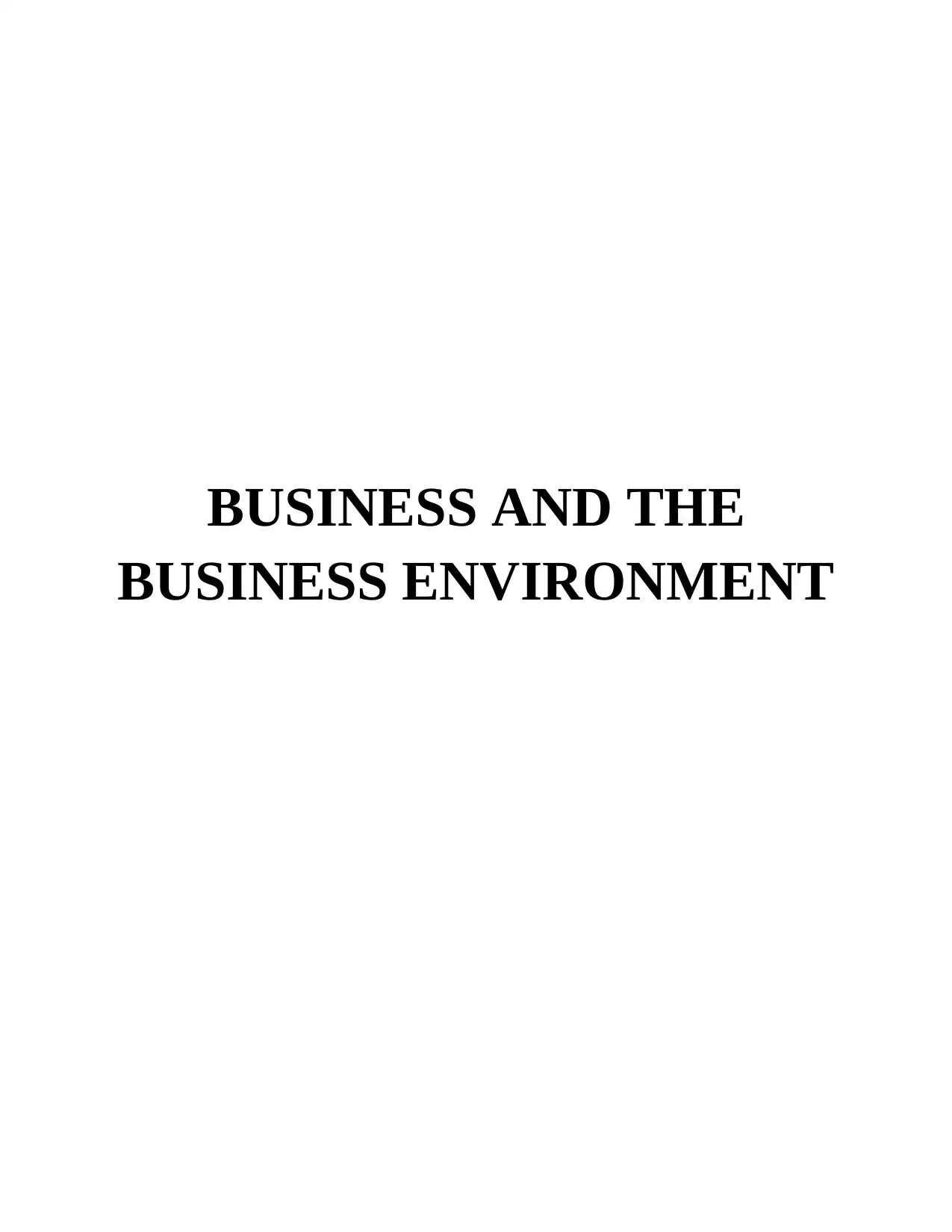
BUSINESS AND THE
BUSINESS ENVIRONMENT
BUSINESS ENVIRONMENT
Paraphrase This Document
Need a fresh take? Get an instant paraphrase of this document with our AI Paraphraser
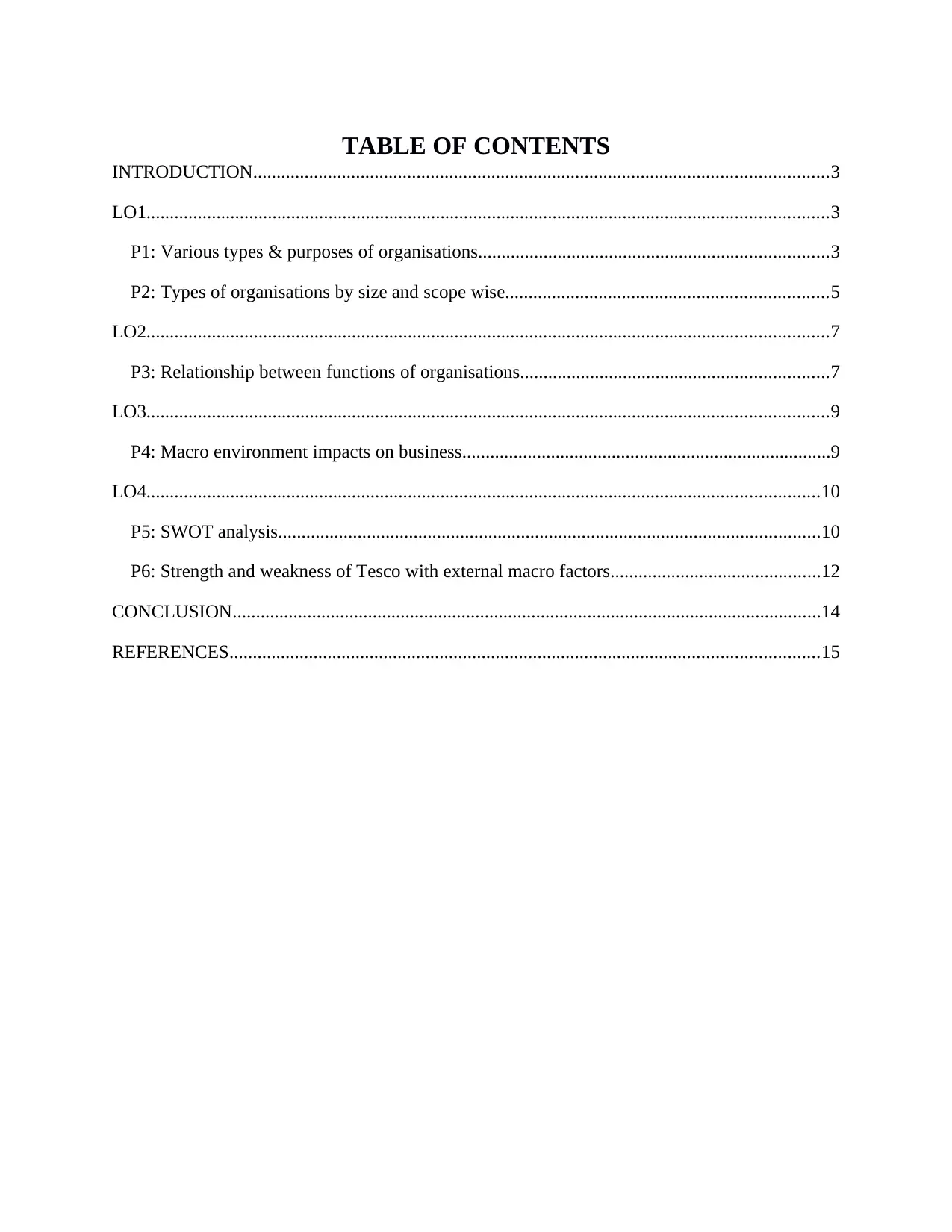
TABLE OF CONTENTS
INTRODUCTION...........................................................................................................................3
LO1..................................................................................................................................................3
P1: Various types & purposes of organisations...........................................................................3
P2: Types of organisations by size and scope wise.....................................................................5
LO2..................................................................................................................................................7
P3: Relationship between functions of organisations..................................................................7
LO3..................................................................................................................................................9
P4: Macro environment impacts on business...............................................................................9
LO4................................................................................................................................................10
P5: SWOT analysis....................................................................................................................10
P6: Strength and weakness of Tesco with external macro factors.............................................12
CONCLUSION..............................................................................................................................14
REFERENCES..............................................................................................................................15
INTRODUCTION...........................................................................................................................3
LO1..................................................................................................................................................3
P1: Various types & purposes of organisations...........................................................................3
P2: Types of organisations by size and scope wise.....................................................................5
LO2..................................................................................................................................................7
P3: Relationship between functions of organisations..................................................................7
LO3..................................................................................................................................................9
P4: Macro environment impacts on business...............................................................................9
LO4................................................................................................................................................10
P5: SWOT analysis....................................................................................................................10
P6: Strength and weakness of Tesco with external macro factors.............................................12
CONCLUSION..............................................................................................................................14
REFERENCES..............................................................................................................................15
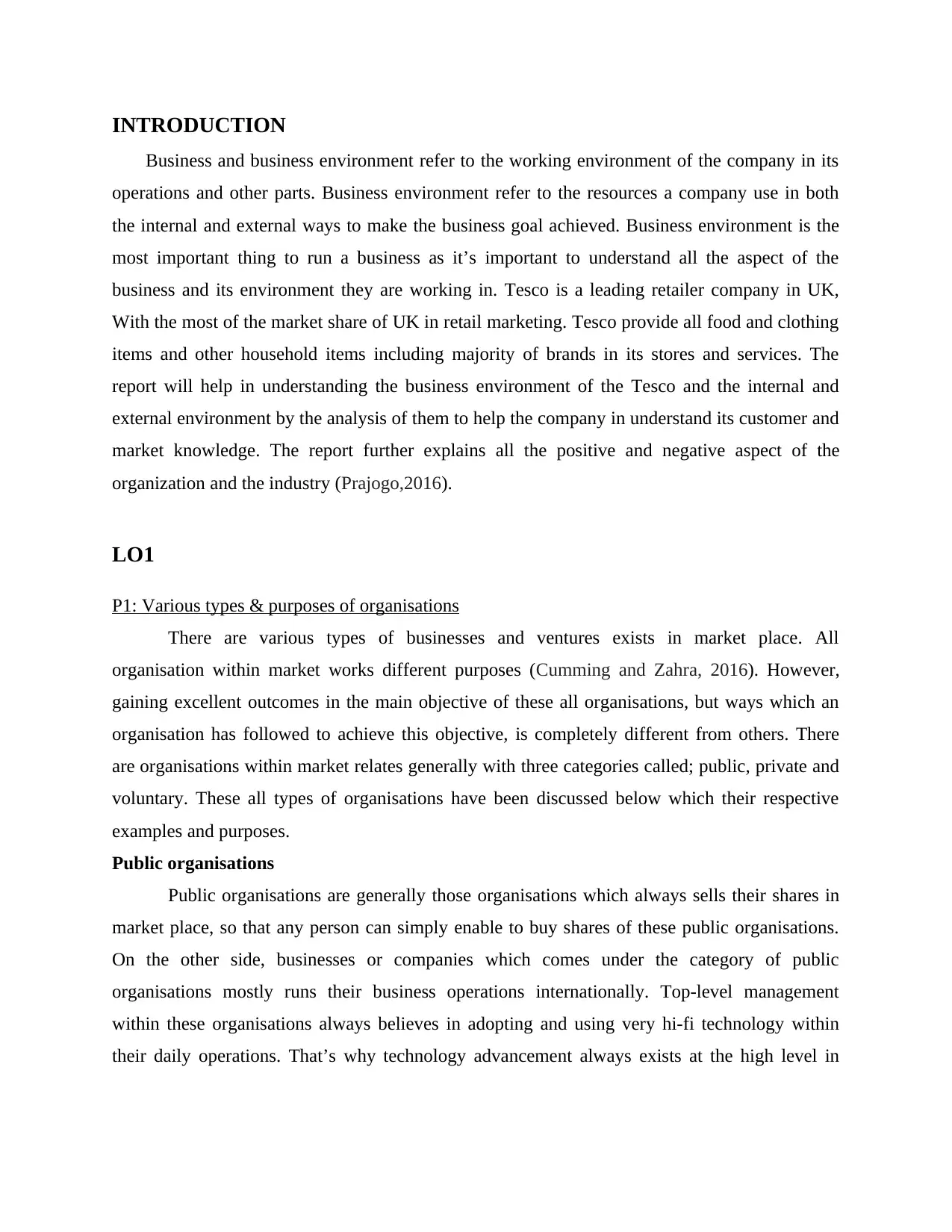
INTRODUCTION
Business and business environment refer to the working environment of the company in its
operations and other parts. Business environment refer to the resources a company use in both
the internal and external ways to make the business goal achieved. Business environment is the
most important thing to run a business as it’s important to understand all the aspect of the
business and its environment they are working in. Tesco is a leading retailer company in UK,
With the most of the market share of UK in retail marketing. Tesco provide all food and clothing
items and other household items including majority of brands in its stores and services. The
report will help in understanding the business environment of the Tesco and the internal and
external environment by the analysis of them to help the company in understand its customer and
market knowledge. The report further explains all the positive and negative aspect of the
organization and the industry (Prajogo,2016).
LO1
P1: Various types & purposes of organisations
There are various types of businesses and ventures exists in market place. All
organisation within market works different purposes (Cumming and Zahra, 2016). However,
gaining excellent outcomes in the main objective of these all organisations, but ways which an
organisation has followed to achieve this objective, is completely different from others. There
are organisations within market relates generally with three categories called; public, private and
voluntary. These all types of organisations have been discussed below which their respective
examples and purposes.
Public organisations
Public organisations are generally those organisations which always sells their shares in
market place, so that any person can simply enable to buy shares of these public organisations.
On the other side, businesses or companies which comes under the category of public
organisations mostly runs their business operations internationally. Top-level management
within these organisations always believes in adopting and using very hi-fi technology within
their daily operations. That’s why technology advancement always exists at the high level in
Business and business environment refer to the working environment of the company in its
operations and other parts. Business environment refer to the resources a company use in both
the internal and external ways to make the business goal achieved. Business environment is the
most important thing to run a business as it’s important to understand all the aspect of the
business and its environment they are working in. Tesco is a leading retailer company in UK,
With the most of the market share of UK in retail marketing. Tesco provide all food and clothing
items and other household items including majority of brands in its stores and services. The
report will help in understanding the business environment of the Tesco and the internal and
external environment by the analysis of them to help the company in understand its customer and
market knowledge. The report further explains all the positive and negative aspect of the
organization and the industry (Prajogo,2016).
LO1
P1: Various types & purposes of organisations
There are various types of businesses and ventures exists in market place. All
organisation within market works different purposes (Cumming and Zahra, 2016). However,
gaining excellent outcomes in the main objective of these all organisations, but ways which an
organisation has followed to achieve this objective, is completely different from others. There
are organisations within market relates generally with three categories called; public, private and
voluntary. These all types of organisations have been discussed below which their respective
examples and purposes.
Public organisations
Public organisations are generally those organisations which always sells their shares in
market place, so that any person can simply enable to buy shares of these public organisations.
On the other side, businesses or companies which comes under the category of public
organisations mostly runs their business operations internationally. Top-level management
within these organisations always believes in adopting and using very hi-fi technology within
their daily operations. That’s why technology advancement always exists at the high level in
⊘ This is a preview!⊘
Do you want full access?
Subscribe today to unlock all pages.

Trusted by 1+ million students worldwide
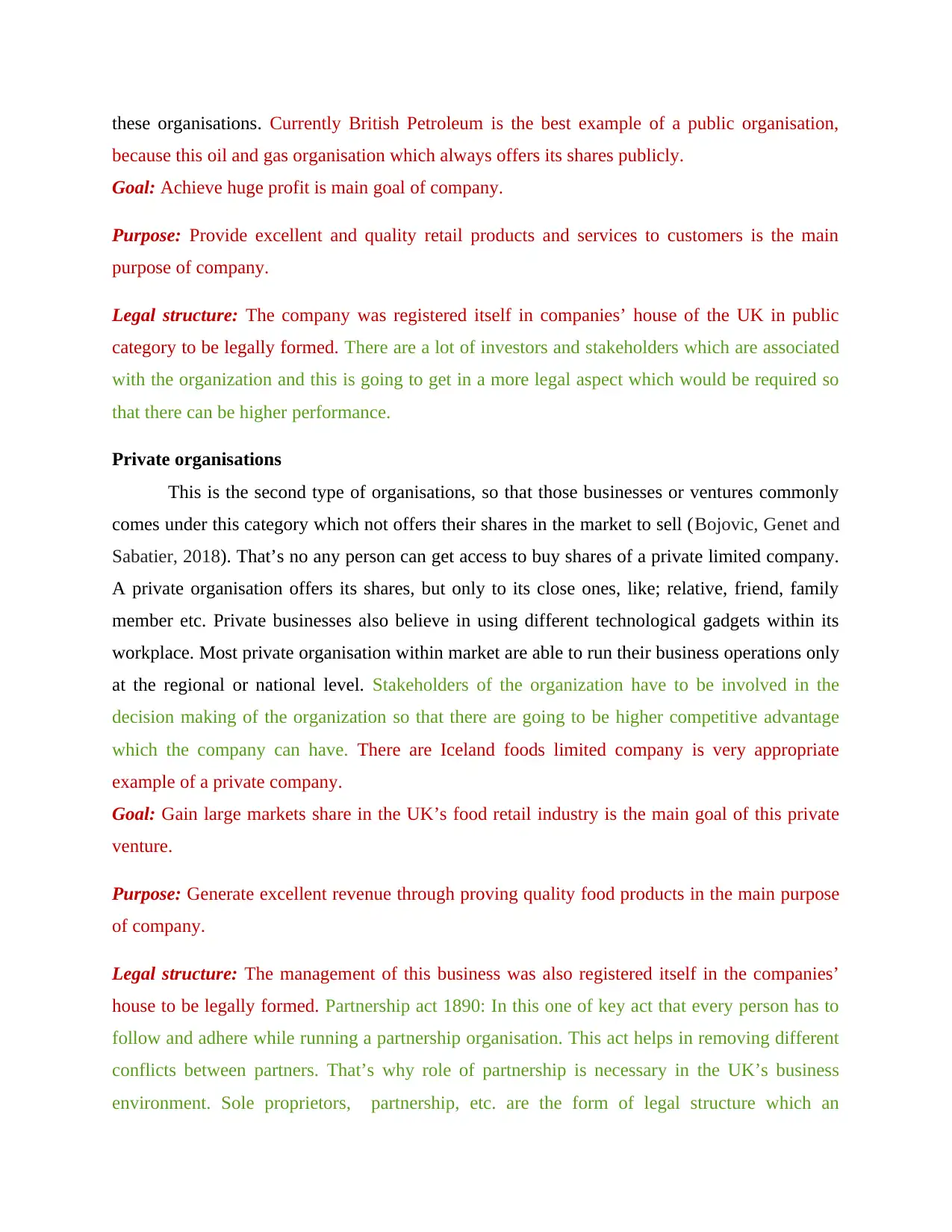
these organisations. Currently British Petroleum is the best example of a public organisation,
because this oil and gas organisation which always offers its shares publicly.
Goal: Achieve huge profit is main goal of company.
Purpose: Provide excellent and quality retail products and services to customers is the main
purpose of company.
Legal structure: The company was registered itself in companies’ house of the UK in public
category to be legally formed. There are a lot of investors and stakeholders which are associated
with the organization and this is going to get in a more legal aspect which would be required so
that there can be higher performance.
Private organisations
This is the second type of organisations, so that those businesses or ventures commonly
comes under this category which not offers their shares in the market to sell (Bojovic, Genet and
Sabatier, 2018). That’s no any person can get access to buy shares of a private limited company.
A private organisation offers its shares, but only to its close ones, like; relative, friend, family
member etc. Private businesses also believe in using different technological gadgets within its
workplace. Most private organisation within market are able to run their business operations only
at the regional or national level. Stakeholders of the organization have to be involved in the
decision making of the organization so that there are going to be higher competitive advantage
which the company can have. There are Iceland foods limited company is very appropriate
example of a private company.
Goal: Gain large markets share in the UK’s food retail industry is the main goal of this private
venture.
Purpose: Generate excellent revenue through proving quality food products in the main purpose
of company.
Legal structure: The management of this business was also registered itself in the companies’
house to be legally formed. Partnership act 1890: In this one of key act that every person has to
follow and adhere while running a partnership organisation. This act helps in removing different
conflicts between partners. That’s why role of partnership is necessary in the UK’s business
environment. Sole proprietors, partnership, etc. are the form of legal structure which an
because this oil and gas organisation which always offers its shares publicly.
Goal: Achieve huge profit is main goal of company.
Purpose: Provide excellent and quality retail products and services to customers is the main
purpose of company.
Legal structure: The company was registered itself in companies’ house of the UK in public
category to be legally formed. There are a lot of investors and stakeholders which are associated
with the organization and this is going to get in a more legal aspect which would be required so
that there can be higher performance.
Private organisations
This is the second type of organisations, so that those businesses or ventures commonly
comes under this category which not offers their shares in the market to sell (Bojovic, Genet and
Sabatier, 2018). That’s no any person can get access to buy shares of a private limited company.
A private organisation offers its shares, but only to its close ones, like; relative, friend, family
member etc. Private businesses also believe in using different technological gadgets within its
workplace. Most private organisation within market are able to run their business operations only
at the regional or national level. Stakeholders of the organization have to be involved in the
decision making of the organization so that there are going to be higher competitive advantage
which the company can have. There are Iceland foods limited company is very appropriate
example of a private company.
Goal: Gain large markets share in the UK’s food retail industry is the main goal of this private
venture.
Purpose: Generate excellent revenue through proving quality food products in the main purpose
of company.
Legal structure: The management of this business was also registered itself in the companies’
house to be legally formed. Partnership act 1890: In this one of key act that every person has to
follow and adhere while running a partnership organisation. This act helps in removing different
conflicts between partners. That’s why role of partnership is necessary in the UK’s business
environment. Sole proprietors, partnership, etc. are the form of legal structure which an
Paraphrase This Document
Need a fresh take? Get an instant paraphrase of this document with our AI Paraphraser
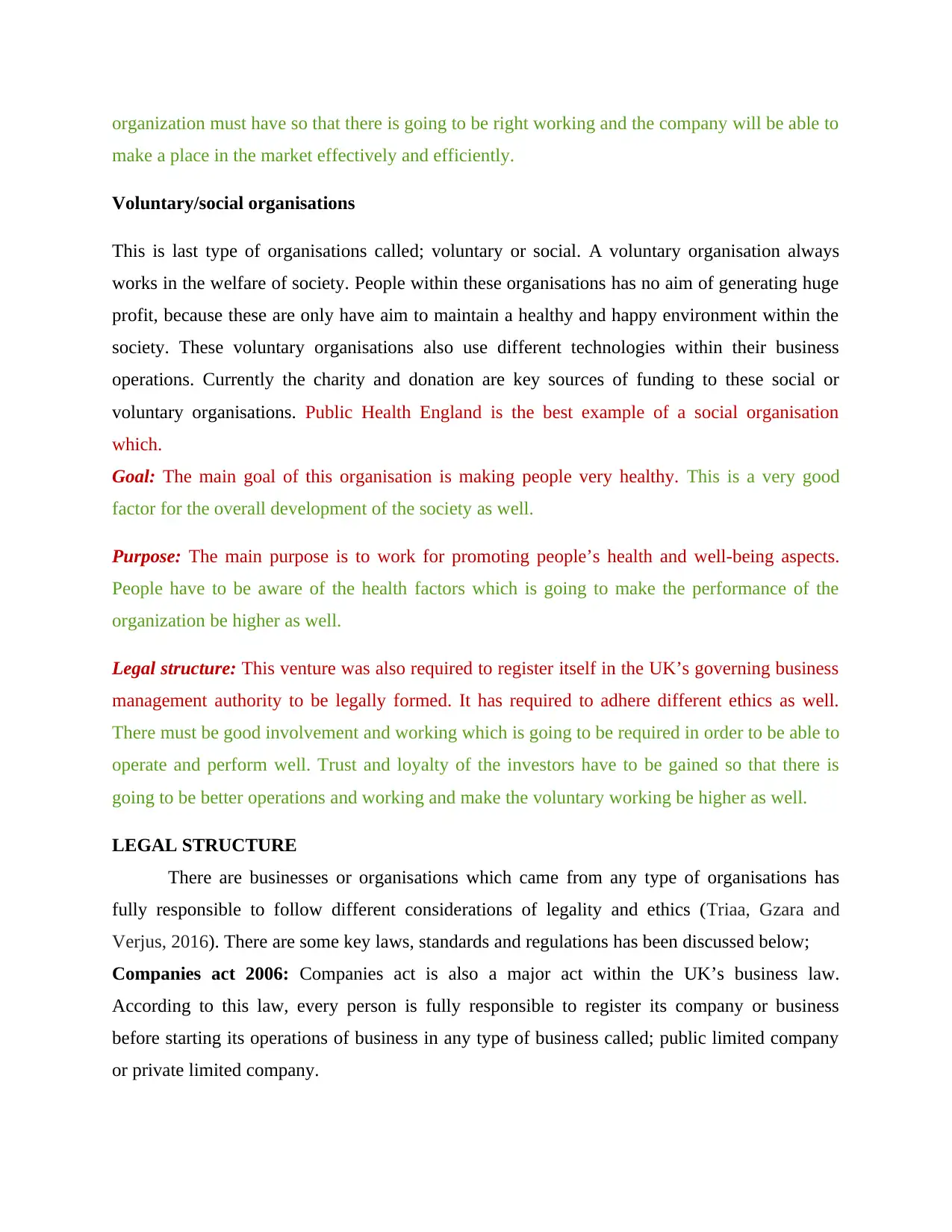
organization must have so that there is going to be right working and the company will be able to
make a place in the market effectively and efficiently.
Voluntary/social organisations
This is last type of organisations called; voluntary or social. A voluntary organisation always
works in the welfare of society. People within these organisations has no aim of generating huge
profit, because these are only have aim to maintain a healthy and happy environment within the
society. These voluntary organisations also use different technologies within their business
operations. Currently the charity and donation are key sources of funding to these social or
voluntary organisations. Public Health England is the best example of a social organisation
which.
Goal: The main goal of this organisation is making people very healthy. This is a very good
factor for the overall development of the society as well.
Purpose: The main purpose is to work for promoting people’s health and well-being aspects.
People have to be aware of the health factors which is going to make the performance of the
organization be higher as well.
Legal structure: This venture was also required to register itself in the UK’s governing business
management authority to be legally formed. It has required to adhere different ethics as well.
There must be good involvement and working which is going to be required in order to be able to
operate and perform well. Trust and loyalty of the investors have to be gained so that there is
going to be better operations and working and make the voluntary working be higher as well.
LEGAL STRUCTURE
There are businesses or organisations which came from any type of organisations has
fully responsible to follow different considerations of legality and ethics (Triaa, Gzara and
Verjus, 2016). There are some key laws, standards and regulations has been discussed below;
Companies act 2006: Companies act is also a major act within the UK’s business law.
According to this law, every person is fully responsible to register its company or business
before starting its operations of business in any type of business called; public limited company
or private limited company.
make a place in the market effectively and efficiently.
Voluntary/social organisations
This is last type of organisations called; voluntary or social. A voluntary organisation always
works in the welfare of society. People within these organisations has no aim of generating huge
profit, because these are only have aim to maintain a healthy and happy environment within the
society. These voluntary organisations also use different technologies within their business
operations. Currently the charity and donation are key sources of funding to these social or
voluntary organisations. Public Health England is the best example of a social organisation
which.
Goal: The main goal of this organisation is making people very healthy. This is a very good
factor for the overall development of the society as well.
Purpose: The main purpose is to work for promoting people’s health and well-being aspects.
People have to be aware of the health factors which is going to make the performance of the
organization be higher as well.
Legal structure: This venture was also required to register itself in the UK’s governing business
management authority to be legally formed. It has required to adhere different ethics as well.
There must be good involvement and working which is going to be required in order to be able to
operate and perform well. Trust and loyalty of the investors have to be gained so that there is
going to be better operations and working and make the voluntary working be higher as well.
LEGAL STRUCTURE
There are businesses or organisations which came from any type of organisations has
fully responsible to follow different considerations of legality and ethics (Triaa, Gzara and
Verjus, 2016). There are some key laws, standards and regulations has been discussed below;
Companies act 2006: Companies act is also a major act within the UK’s business law.
According to this law, every person is fully responsible to register its company or business
before starting its operations of business in any type of business called; public limited company
or private limited company.
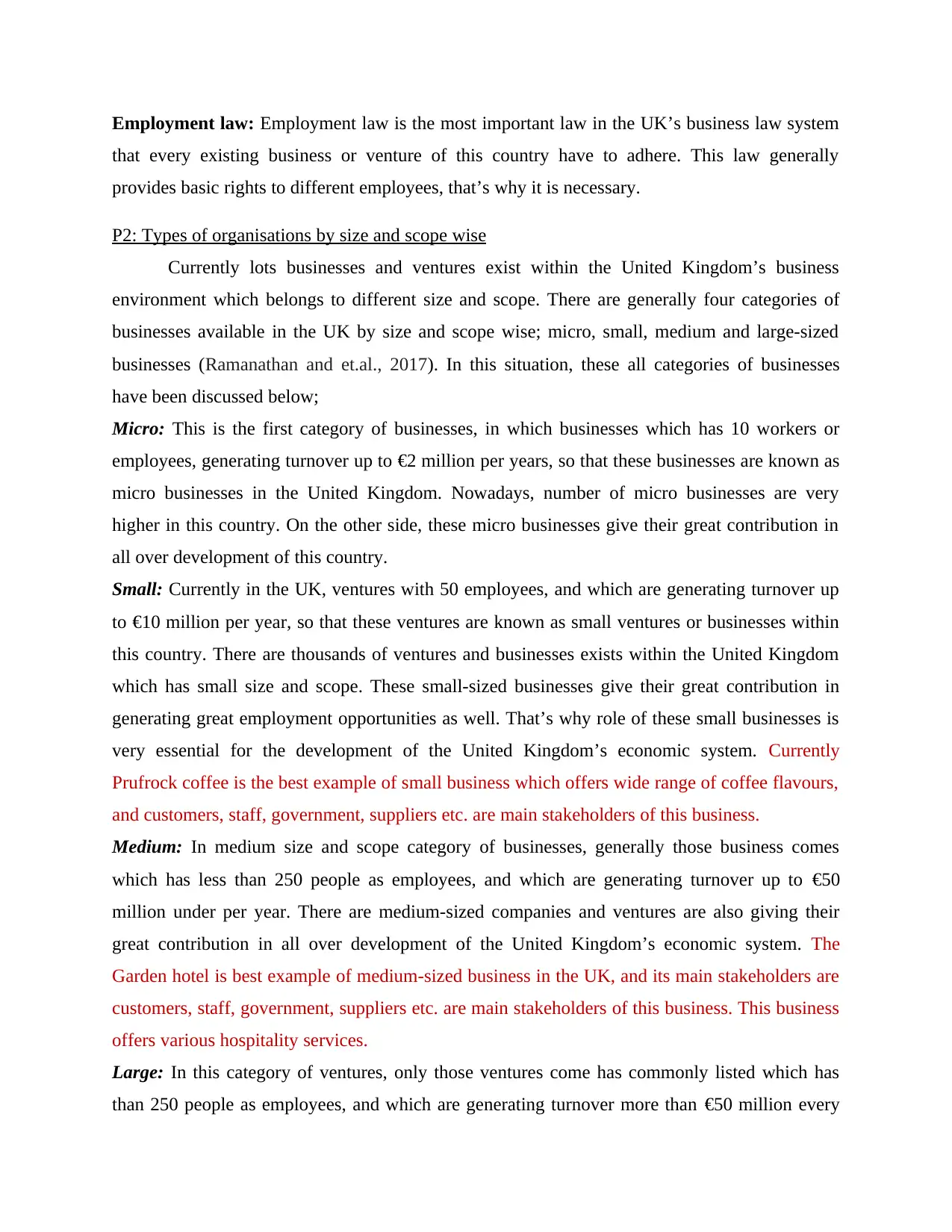
Employment law: Employment law is the most important law in the UK’s business law system
that every existing business or venture of this country have to adhere. This law generally
provides basic rights to different employees, that’s why it is necessary.
P2: Types of organisations by size and scope wise
Currently lots businesses and ventures exist within the United Kingdom’s business
environment which belongs to different size and scope. There are generally four categories of
businesses available in the UK by size and scope wise; micro, small, medium and large-sized
businesses (Ramanathan and et.al., 2017). In this situation, these all categories of businesses
have been discussed below;
Micro: This is the first category of businesses, in which businesses which has 10 workers or
employees, generating turnover up to €2 million per years, so that these businesses are known as
micro businesses in the United Kingdom. Nowadays, number of micro businesses are very
higher in this country. On the other side, these micro businesses give their great contribution in
all over development of this country.
Small: Currently in the UK, ventures with 50 employees, and which are generating turnover up
to €10 million per year, so that these ventures are known as small ventures or businesses within
this country. There are thousands of ventures and businesses exists within the United Kingdom
which has small size and scope. These small-sized businesses give their great contribution in
generating great employment opportunities as well. That’s why role of these small businesses is
very essential for the development of the United Kingdom’s economic system. Currently
Prufrock coffee is the best example of small business which offers wide range of coffee flavours,
and customers, staff, government, suppliers etc. are main stakeholders of this business.
Medium: In medium size and scope category of businesses, generally those business comes
which has less than 250 people as employees, and which are generating turnover up to €50
million under per year. There are medium-sized companies and ventures are also giving their
great contribution in all over development of the United Kingdom’s economic system. The
Garden hotel is best example of medium-sized business in the UK, and its main stakeholders are
customers, staff, government, suppliers etc. are main stakeholders of this business. This business
offers various hospitality services.
Large: In this category of ventures, only those ventures come has commonly listed which has
than 250 people as employees, and which are generating turnover more than €50 million every
that every existing business or venture of this country have to adhere. This law generally
provides basic rights to different employees, that’s why it is necessary.
P2: Types of organisations by size and scope wise
Currently lots businesses and ventures exist within the United Kingdom’s business
environment which belongs to different size and scope. There are generally four categories of
businesses available in the UK by size and scope wise; micro, small, medium and large-sized
businesses (Ramanathan and et.al., 2017). In this situation, these all categories of businesses
have been discussed below;
Micro: This is the first category of businesses, in which businesses which has 10 workers or
employees, generating turnover up to €2 million per years, so that these businesses are known as
micro businesses in the United Kingdom. Nowadays, number of micro businesses are very
higher in this country. On the other side, these micro businesses give their great contribution in
all over development of this country.
Small: Currently in the UK, ventures with 50 employees, and which are generating turnover up
to €10 million per year, so that these ventures are known as small ventures or businesses within
this country. There are thousands of ventures and businesses exists within the United Kingdom
which has small size and scope. These small-sized businesses give their great contribution in
generating great employment opportunities as well. That’s why role of these small businesses is
very essential for the development of the United Kingdom’s economic system. Currently
Prufrock coffee is the best example of small business which offers wide range of coffee flavours,
and customers, staff, government, suppliers etc. are main stakeholders of this business.
Medium: In medium size and scope category of businesses, generally those business comes
which has less than 250 people as employees, and which are generating turnover up to €50
million under per year. There are medium-sized companies and ventures are also giving their
great contribution in all over development of the United Kingdom’s economic system. The
Garden hotel is best example of medium-sized business in the UK, and its main stakeholders are
customers, staff, government, suppliers etc. are main stakeholders of this business. This business
offers various hospitality services.
Large: In this category of ventures, only those ventures come has commonly listed which has
than 250 people as employees, and which are generating turnover more than €50 million every
⊘ This is a preview!⊘
Do you want full access?
Subscribe today to unlock all pages.

Trusted by 1+ million students worldwide
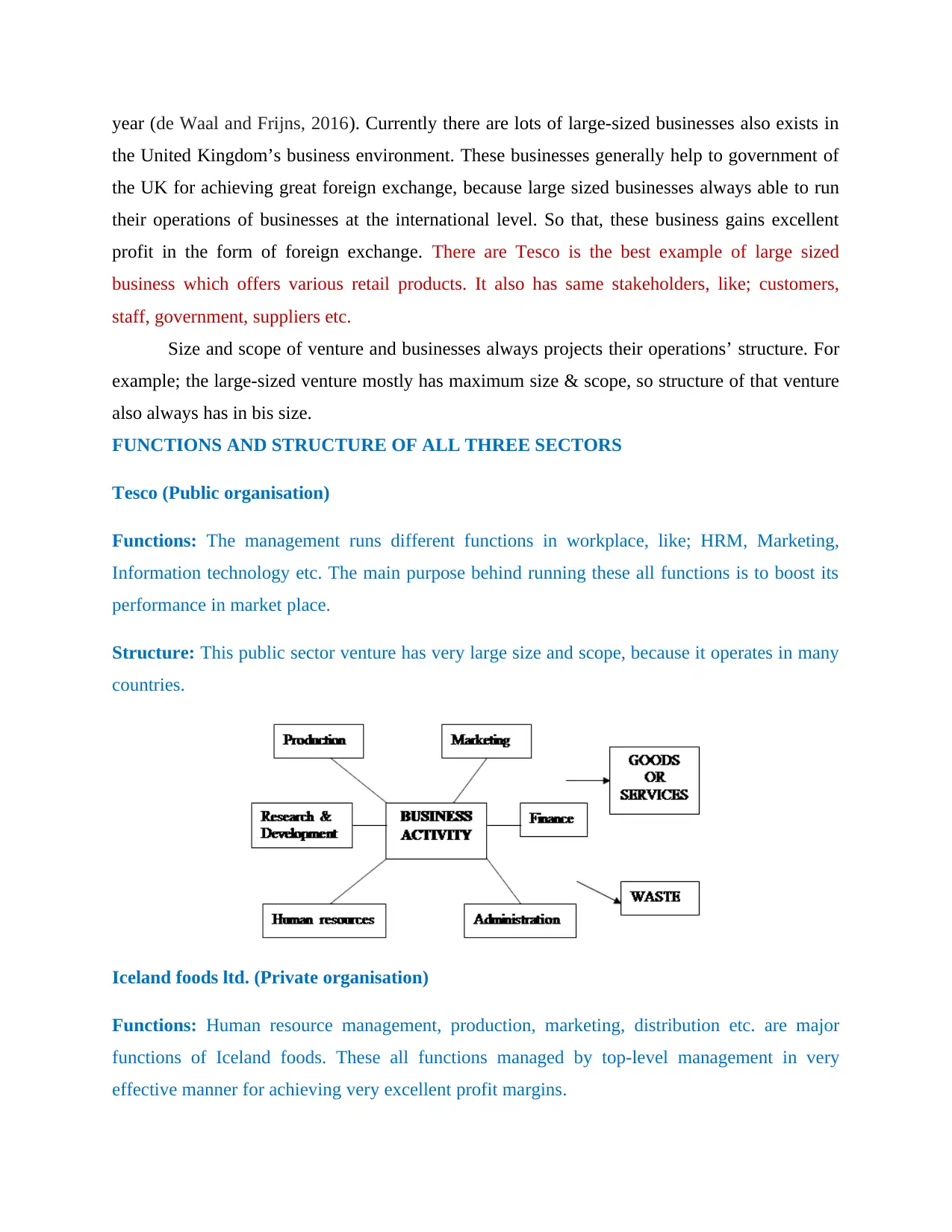
year (de Waal and Frijns, 2016). Currently there are lots of large-sized businesses also exists in
the United Kingdom’s business environment. These businesses generally help to government of
the UK for achieving great foreign exchange, because large sized businesses always able to run
their operations of businesses at the international level. So that, these business gains excellent
profit in the form of foreign exchange. There are Tesco is the best example of large sized
business which offers various retail products. It also has same stakeholders, like; customers,
staff, government, suppliers etc.
Size and scope of venture and businesses always projects their operations’ structure. For
example; the large-sized venture mostly has maximum size & scope, so structure of that venture
also always has in bis size.
FUNCTIONS AND STRUCTURE OF ALL THREE SECTORS
Tesco (Public organisation)
Functions: The management runs different functions in workplace, like; HRM, Marketing,
Information technology etc. The main purpose behind running these all functions is to boost its
performance in market place.
Structure: This public sector venture has very large size and scope, because it operates in many
countries.
Iceland foods ltd. (Private organisation)
Functions: Human resource management, production, marketing, distribution etc. are major
functions of Iceland foods. These all functions managed by top-level management in very
effective manner for achieving very excellent profit margins.
the United Kingdom’s business environment. These businesses generally help to government of
the UK for achieving great foreign exchange, because large sized businesses always able to run
their operations of businesses at the international level. So that, these business gains excellent
profit in the form of foreign exchange. There are Tesco is the best example of large sized
business which offers various retail products. It also has same stakeholders, like; customers,
staff, government, suppliers etc.
Size and scope of venture and businesses always projects their operations’ structure. For
example; the large-sized venture mostly has maximum size & scope, so structure of that venture
also always has in bis size.
FUNCTIONS AND STRUCTURE OF ALL THREE SECTORS
Tesco (Public organisation)
Functions: The management runs different functions in workplace, like; HRM, Marketing,
Information technology etc. The main purpose behind running these all functions is to boost its
performance in market place.
Structure: This public sector venture has very large size and scope, because it operates in many
countries.
Iceland foods ltd. (Private organisation)
Functions: Human resource management, production, marketing, distribution etc. are major
functions of Iceland foods. These all functions managed by top-level management in very
effective manner for achieving very excellent profit margins.
Paraphrase This Document
Need a fresh take? Get an instant paraphrase of this document with our AI Paraphraser
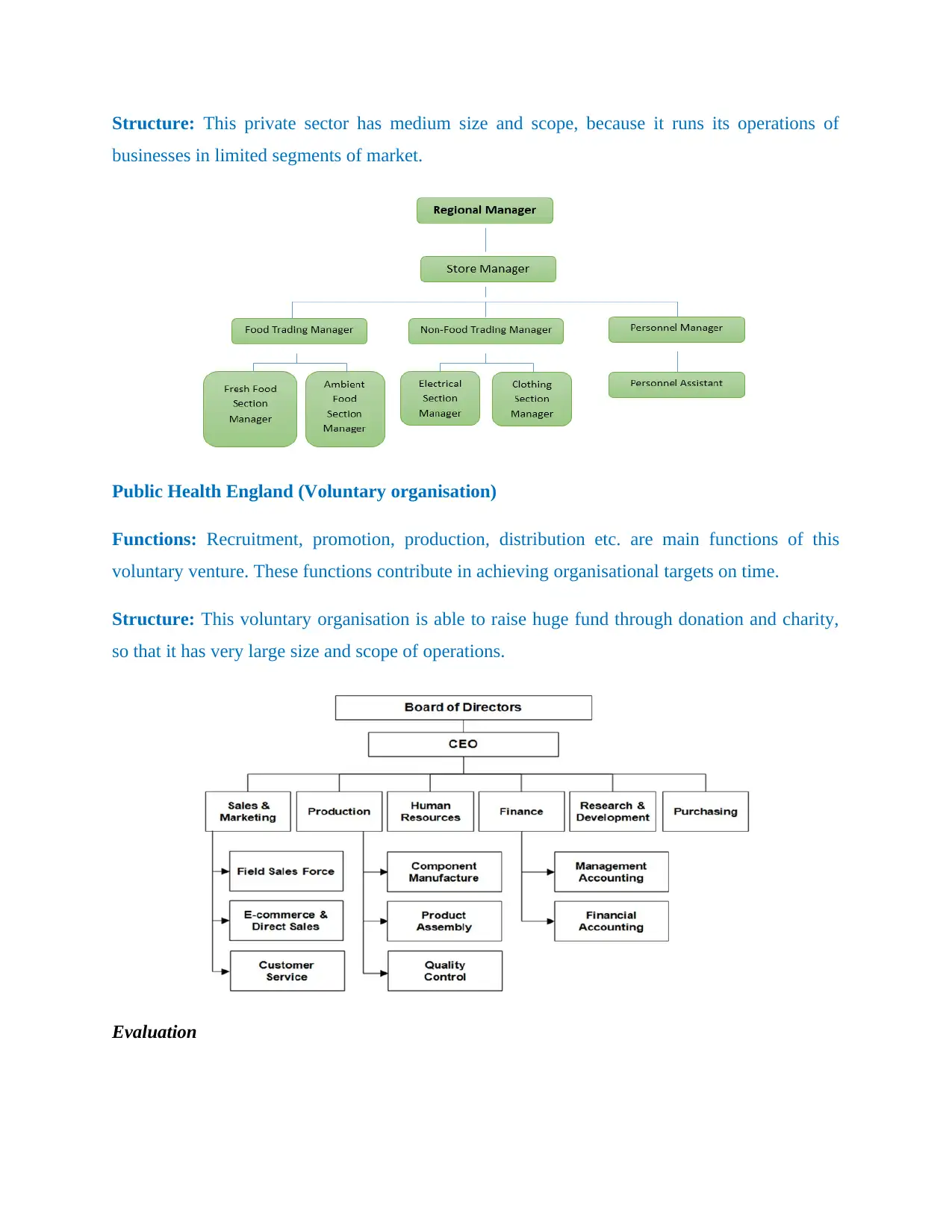
Structure: This private sector has medium size and scope, because it runs its operations of
businesses in limited segments of market.
Public Health England (Voluntary organisation)
Functions: Recruitment, promotion, production, distribution etc. are main functions of this
voluntary venture. These functions contribute in achieving organisational targets on time.
Structure: This voluntary organisation is able to raise huge fund through donation and charity,
so that it has very large size and scope of operations.
Evaluation
businesses in limited segments of market.
Public Health England (Voluntary organisation)
Functions: Recruitment, promotion, production, distribution etc. are main functions of this
voluntary venture. These functions contribute in achieving organisational targets on time.
Structure: This voluntary organisation is able to raise huge fund through donation and charity,
so that it has very large size and scope of operations.
Evaluation
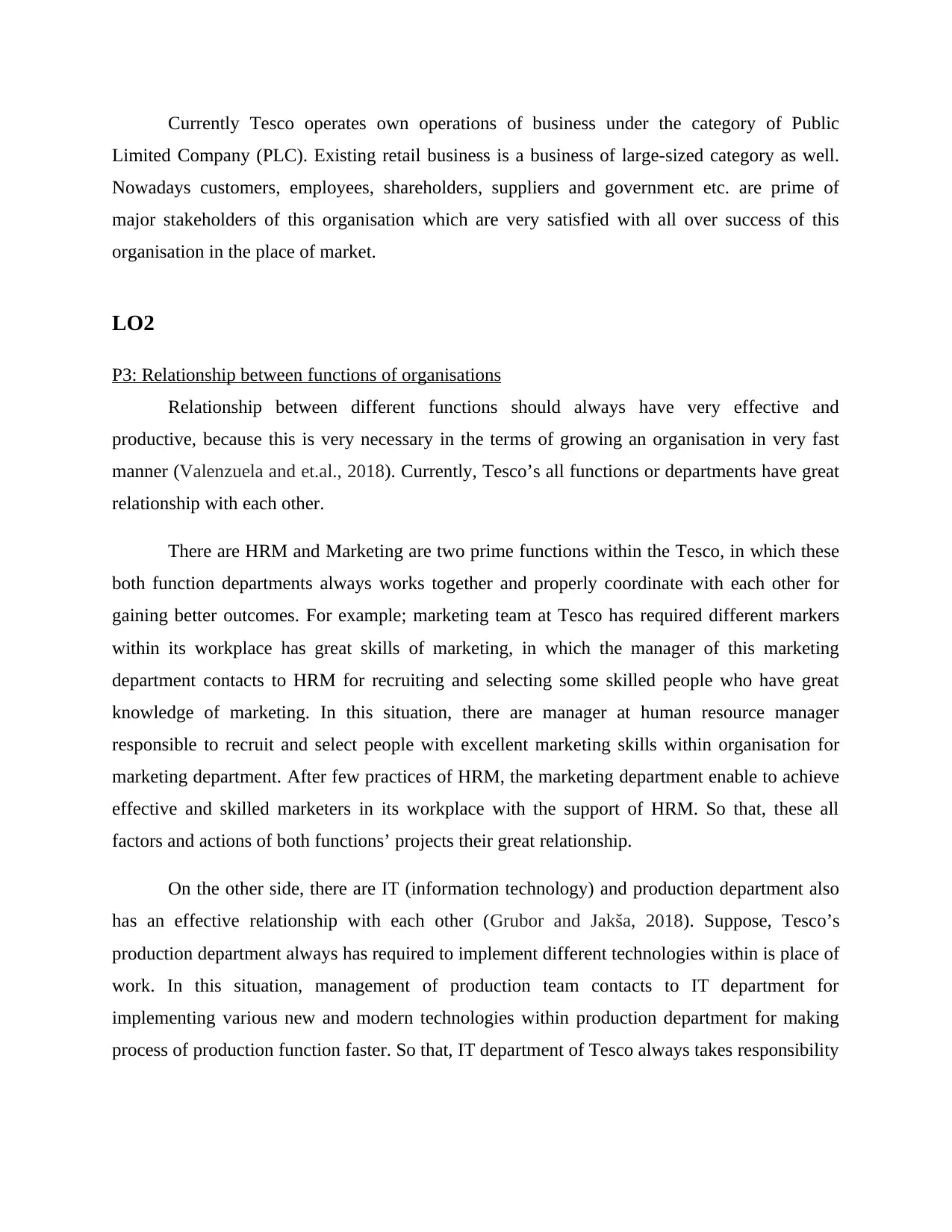
Currently Tesco operates own operations of business under the category of Public
Limited Company (PLC). Existing retail business is a business of large-sized category as well.
Nowadays customers, employees, shareholders, suppliers and government etc. are prime of
major stakeholders of this organisation which are very satisfied with all over success of this
organisation in the place of market.
LO2
P3: Relationship between functions of organisations
Relationship between different functions should always have very effective and
productive, because this is very necessary in the terms of growing an organisation in very fast
manner (Valenzuela and et.al., 2018). Currently, Tesco’s all functions or departments have great
relationship with each other.
There are HRM and Marketing are two prime functions within the Tesco, in which these
both function departments always works together and properly coordinate with each other for
gaining better outcomes. For example; marketing team at Tesco has required different markers
within its workplace has great skills of marketing, in which the manager of this marketing
department contacts to HRM for recruiting and selecting some skilled people who have great
knowledge of marketing. In this situation, there are manager at human resource manager
responsible to recruit and select people with excellent marketing skills within organisation for
marketing department. After few practices of HRM, the marketing department enable to achieve
effective and skilled marketers in its workplace with the support of HRM. So that, these all
factors and actions of both functions’ projects their great relationship.
On the other side, there are IT (information technology) and production department also
has an effective relationship with each other (Grubor and Jakša, 2018). Suppose, Tesco’s
production department always has required to implement different technologies within is place of
work. In this situation, management of production team contacts to IT department for
implementing various new and modern technologies within production department for making
process of production function faster. So that, IT department of Tesco always takes responsibility
Limited Company (PLC). Existing retail business is a business of large-sized category as well.
Nowadays customers, employees, shareholders, suppliers and government etc. are prime of
major stakeholders of this organisation which are very satisfied with all over success of this
organisation in the place of market.
LO2
P3: Relationship between functions of organisations
Relationship between different functions should always have very effective and
productive, because this is very necessary in the terms of growing an organisation in very fast
manner (Valenzuela and et.al., 2018). Currently, Tesco’s all functions or departments have great
relationship with each other.
There are HRM and Marketing are two prime functions within the Tesco, in which these
both function departments always works together and properly coordinate with each other for
gaining better outcomes. For example; marketing team at Tesco has required different markers
within its workplace has great skills of marketing, in which the manager of this marketing
department contacts to HRM for recruiting and selecting some skilled people who have great
knowledge of marketing. In this situation, there are manager at human resource manager
responsible to recruit and select people with excellent marketing skills within organisation for
marketing department. After few practices of HRM, the marketing department enable to achieve
effective and skilled marketers in its workplace with the support of HRM. So that, these all
factors and actions of both functions’ projects their great relationship.
On the other side, there are IT (information technology) and production department also
has an effective relationship with each other (Grubor and Jakša, 2018). Suppose, Tesco’s
production department always has required to implement different technologies within is place of
work. In this situation, management of production team contacts to IT department for
implementing various new and modern technologies within production department for making
process of production function faster. So that, IT department of Tesco always takes responsibility
⊘ This is a preview!⊘
Do you want full access?
Subscribe today to unlock all pages.

Trusted by 1+ million students worldwide
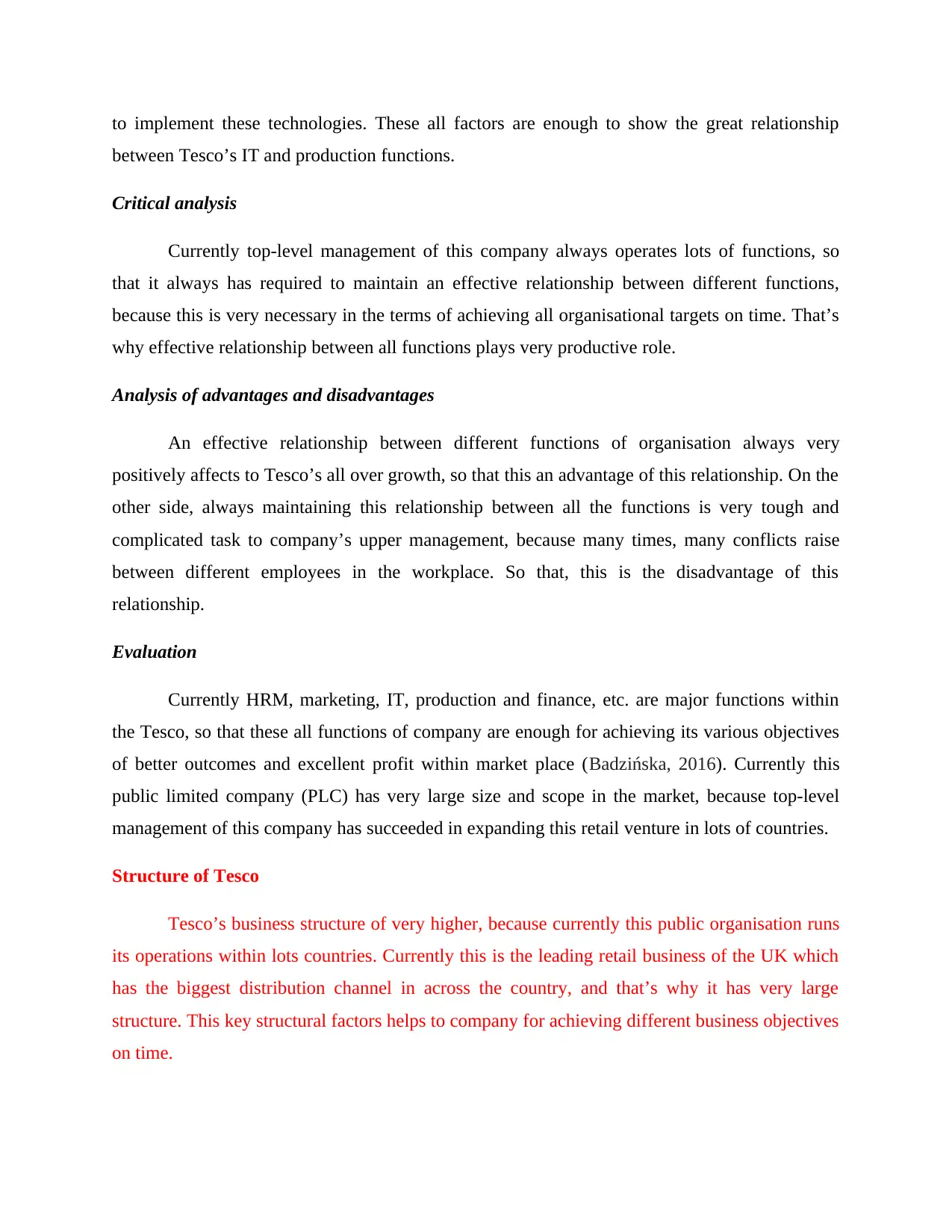
to implement these technologies. These all factors are enough to show the great relationship
between Tesco’s IT and production functions.
Critical analysis
Currently top-level management of this company always operates lots of functions, so
that it always has required to maintain an effective relationship between different functions,
because this is very necessary in the terms of achieving all organisational targets on time. That’s
why effective relationship between all functions plays very productive role.
Analysis of advantages and disadvantages
An effective relationship between different functions of organisation always very
positively affects to Tesco’s all over growth, so that this an advantage of this relationship. On the
other side, always maintaining this relationship between all the functions is very tough and
complicated task to company’s upper management, because many times, many conflicts raise
between different employees in the workplace. So that, this is the disadvantage of this
relationship.
Evaluation
Currently HRM, marketing, IT, production and finance, etc. are major functions within
the Tesco, so that these all functions of company are enough for achieving its various objectives
of better outcomes and excellent profit within market place (Badzińska, 2016). Currently this
public limited company (PLC) has very large size and scope in the market, because top-level
management of this company has succeeded in expanding this retail venture in lots of countries.
Structure of Tesco
Tesco’s business structure of very higher, because currently this public organisation runs
its operations within lots countries. Currently this is the leading retail business of the UK which
has the biggest distribution channel in across the country, and that’s why it has very large
structure. This key structural factors helps to company for achieving different business objectives
on time.
between Tesco’s IT and production functions.
Critical analysis
Currently top-level management of this company always operates lots of functions, so
that it always has required to maintain an effective relationship between different functions,
because this is very necessary in the terms of achieving all organisational targets on time. That’s
why effective relationship between all functions plays very productive role.
Analysis of advantages and disadvantages
An effective relationship between different functions of organisation always very
positively affects to Tesco’s all over growth, so that this an advantage of this relationship. On the
other side, always maintaining this relationship between all the functions is very tough and
complicated task to company’s upper management, because many times, many conflicts raise
between different employees in the workplace. So that, this is the disadvantage of this
relationship.
Evaluation
Currently HRM, marketing, IT, production and finance, etc. are major functions within
the Tesco, so that these all functions of company are enough for achieving its various objectives
of better outcomes and excellent profit within market place (Badzińska, 2016). Currently this
public limited company (PLC) has very large size and scope in the market, because top-level
management of this company has succeeded in expanding this retail venture in lots of countries.
Structure of Tesco
Tesco’s business structure of very higher, because currently this public organisation runs
its operations within lots countries. Currently this is the leading retail business of the UK which
has the biggest distribution channel in across the country, and that’s why it has very large
structure. This key structural factors helps to company for achieving different business objectives
on time.
Paraphrase This Document
Need a fresh take? Get an instant paraphrase of this document with our AI Paraphraser

LO3
P4: Macro environment impacts on business
For analysing the impact of macro environment on Tesco, there are PESTLE analysis
model has used below. This model is very efficient in the terms of deifying different key macro
or external factors of business environment.
PESTEL Analysis
Figure 1: Tesco's Pestel Analysis
Source: (Tesco Pestel Analysis, 2018)
PESTLE analysis tool or model is currently used by many of companies and ventures
within market place, because this model plays great role for knowing the impact of different key
external factors. This model generally indicates six key external factors of Tesco’s business
environment, which has been mentioned below;
Political factor: Political factors of the United Kingdom always affects Tesco both manners. For
example; government of the United Kingdom has provided an effective framework of business
law which support to all businesses to run their operations ethically and legally, so that this
positive impact of these factors (Corradini, Polzonetti and Riganelli, 2018). On the other side,
imposed very high rate of taxation on different business, so that this negative impact of political
factors on Tesco.
P4: Macro environment impacts on business
For analysing the impact of macro environment on Tesco, there are PESTLE analysis
model has used below. This model is very efficient in the terms of deifying different key macro
or external factors of business environment.
PESTEL Analysis
Figure 1: Tesco's Pestel Analysis
Source: (Tesco Pestel Analysis, 2018)
PESTLE analysis tool or model is currently used by many of companies and ventures
within market place, because this model plays great role for knowing the impact of different key
external factors. This model generally indicates six key external factors of Tesco’s business
environment, which has been mentioned below;
Political factor: Political factors of the United Kingdom always affects Tesco both manners. For
example; government of the United Kingdom has provided an effective framework of business
law which support to all businesses to run their operations ethically and legally, so that this
positive impact of these factors (Corradini, Polzonetti and Riganelli, 2018). On the other side,
imposed very high rate of taxation on different business, so that this negative impact of political
factors on Tesco.
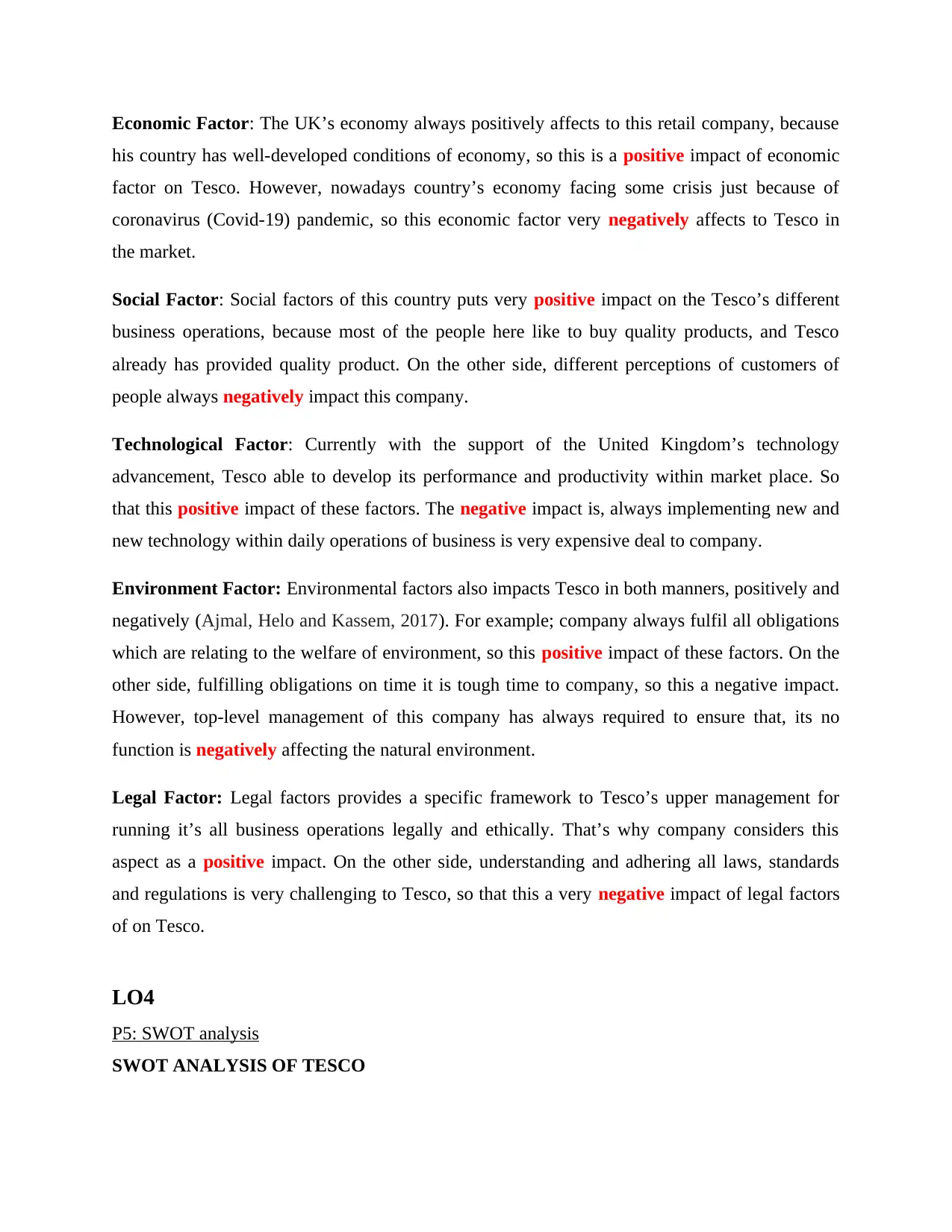
Economic Factor: The UK’s economy always positively affects to this retail company, because
his country has well-developed conditions of economy, so this is a positive impact of economic
factor on Tesco. However, nowadays country’s economy facing some crisis just because of
coronavirus (Covid-19) pandemic, so this economic factor very negatively affects to Tesco in
the market.
Social Factor: Social factors of this country puts very positive impact on the Tesco’s different
business operations, because most of the people here like to buy quality products, and Tesco
already has provided quality product. On the other side, different perceptions of customers of
people always negatively impact this company.
Technological Factor: Currently with the support of the United Kingdom’s technology
advancement, Tesco able to develop its performance and productivity within market place. So
that this positive impact of these factors. The negative impact is, always implementing new and
new technology within daily operations of business is very expensive deal to company.
Environment Factor: Environmental factors also impacts Tesco in both manners, positively and
negatively (Ajmal, Helo and Kassem, 2017). For example; company always fulfil all obligations
which are relating to the welfare of environment, so this positive impact of these factors. On the
other side, fulfilling obligations on time it is tough time to company, so this a negative impact.
However, top-level management of this company has always required to ensure that, its no
function is negatively affecting the natural environment.
Legal Factor: Legal factors provides a specific framework to Tesco’s upper management for
running it’s all business operations legally and ethically. That’s why company considers this
aspect as a positive impact. On the other side, understanding and adhering all laws, standards
and regulations is very challenging to Tesco, so that this a very negative impact of legal factors
of on Tesco.
LO4
P5: SWOT analysis
SWOT ANALYSIS OF TESCO
his country has well-developed conditions of economy, so this is a positive impact of economic
factor on Tesco. However, nowadays country’s economy facing some crisis just because of
coronavirus (Covid-19) pandemic, so this economic factor very negatively affects to Tesco in
the market.
Social Factor: Social factors of this country puts very positive impact on the Tesco’s different
business operations, because most of the people here like to buy quality products, and Tesco
already has provided quality product. On the other side, different perceptions of customers of
people always negatively impact this company.
Technological Factor: Currently with the support of the United Kingdom’s technology
advancement, Tesco able to develop its performance and productivity within market place. So
that this positive impact of these factors. The negative impact is, always implementing new and
new technology within daily operations of business is very expensive deal to company.
Environment Factor: Environmental factors also impacts Tesco in both manners, positively and
negatively (Ajmal, Helo and Kassem, 2017). For example; company always fulfil all obligations
which are relating to the welfare of environment, so this positive impact of these factors. On the
other side, fulfilling obligations on time it is tough time to company, so this a negative impact.
However, top-level management of this company has always required to ensure that, its no
function is negatively affecting the natural environment.
Legal Factor: Legal factors provides a specific framework to Tesco’s upper management for
running it’s all business operations legally and ethically. That’s why company considers this
aspect as a positive impact. On the other side, understanding and adhering all laws, standards
and regulations is very challenging to Tesco, so that this a very negative impact of legal factors
of on Tesco.
LO4
P5: SWOT analysis
SWOT ANALYSIS OF TESCO
⊘ This is a preview!⊘
Do you want full access?
Subscribe today to unlock all pages.

Trusted by 1+ million students worldwide
1 out of 20
Related Documents
Your All-in-One AI-Powered Toolkit for Academic Success.
+13062052269
info@desklib.com
Available 24*7 on WhatsApp / Email
![[object Object]](/_next/static/media/star-bottom.7253800d.svg)
Unlock your academic potential
Copyright © 2020–2025 A2Z Services. All Rights Reserved. Developed and managed by ZUCOL.





